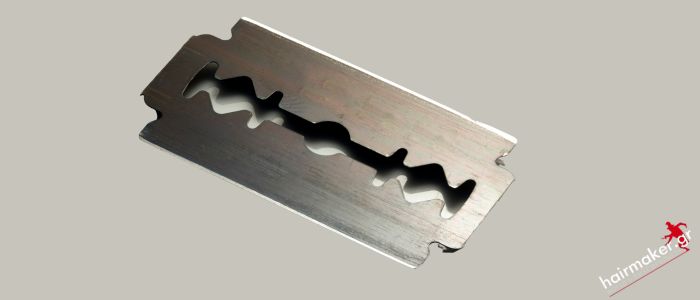- HairMaker.Gr
- Traditional Shaving
- 22 likes
- 5902 views
- 0 comments
- traditional shaving, Shaving, shaving blade, traditional shaving blade, traditional shaving blades
Differences between traditional shaving blades.
The razor blades of traditional shaving machines, both double and single sided, most of them are coated with PTFE (Teflon).
It is a material preferred by manufacturers because it is gentle on the skin, increases the duration and uses of the razor, and also protects it from rust and even some possible manufacturing failure.
In addition to PTFE, coatings of metal oxides (chromium, platinum, etc.) are also used to further harden the blade and theoretically increase its performance (depth of cut).
By essentially using metal oxides with a higher hardness, they aim at creating a blade that offers a deeper shave. Looking at the product packaging, we notice that some simply say stainless (they are PTFE coated), while others are referred to as Super Stainless, Super Chrome, Platinum, Iridium, etc.
Most of these have a PTFE coating combined with a metal oxide.
What are the essential differences between them?
There are several types of traditional razor blades available on the market, each with its own unique characteristics and advantages. Here are some of the main differences between different types of traditional razor blades:
Double-Edge (DE) Razor Blades:
- Double-edge razor blades are the most common type used in traditional safety razors.
- They have two sharp edges, allowing you to use both sides before needing to replace the blade.
- DE blades are known for their sharpness and precision, providing a close shave.
- They come in various materials, including stainless steel and carbon steel, offering different levels of durability and sharpness.
Single-Edge Razor Blades:
- Single-edge razor blades are similar to double-edge blades but have only one sharp edge.
- They are commonly used in vintage razors or specialized shaving tools.
- Single-edge blades are known for their sharpness and provide an excellent shaving experience.
- They are available in various materials and can offer different levels of comfort and sharpness based on the brand and quality.
Straight Razor Blades:
- Straight razors, also known as cutthroat razors or open razors, use a single, long, and foldable blade.
- They require skill and technique to use effectively and safely.
- Straight razor blades provide an exceptionally close shave and are preferred by many shaving enthusiasts.
- They require regular maintenance, including stropping and occasional honing, to keep the blade sharp.
Injector Razor Blades:
- Injector razor blades are designed to be used in specific razors with a built-in blade loading mechanism.
- They feature a unique design where the blade is contained within a cartridge or injector system.
- Injector blades are known for their ease of use and convenience, as they eliminate the need for handling loose blades.
- They come in different materials and can provide a comfortable and efficient shaving experience.
Shavette Blades:
- Shavettes are similar to straight razors but use replaceable blades instead of a fixed blade.
- They offer the benefits of a straight razor without the need for honing or stropping.
- Shavette blades are typically thinner and more flexible than traditional straight razor blades.
- They provide a close shave and are popular among barbers and those who prefer the straight razor experience without the maintenance.
It's important to note that personal preferences, skin sensitivity, and shaving technique can also impact the shaving experience with different razor blades. It may take some experimentation to find the blade type that works best for you.
Which one is the best? Unfortunately the answer is not as obvious as we would like it to be.
This is because there are two other determining factors that determine quality.
The first factor is the quality of the steel used, in relation to the manufacturing process.
A razor that does not have good quality steel as its base will not be good and sharp no matter how many coatings it has.
The second and most important factor is the person using the razor.
In which skin type each razor suits.
The same razor, on two different people, can have a completely different effect. One may consider the shave excellent and the other one may consider the shave average to poor. There is no definitive way to find which coating has a better effect on each different type of hair and skin.
For example, if a razor has a coating that has a lower hardness, it does not mean it is of poor quality.
That razor may be better suited to someone with fine and sparse hairs and sensitive skin.
The blade will be gentler and less (comparatively) sharp, but it will be sufficient to cut the finest hairs without irritating sensitive skin, on which a sharper blade would cause redness.
Similarly, on a dry skin with a rich and coarse beard it may not give the desired result. In the end, it is personal preference and compatibility with the material that matters most.
Traditional shaving blade tests are our best ally.
For better or worse, testing different blades and machines is the only way to sort out what works for us and what suits our face and find the best possible result for us.
Test each razor on at least 2-3 shaves as the behavior changes from shave to shave.
HairMaker.Gr has one of the largest collection of traditional shaving blades so you can choose among the best blades on the market.









Comments (0)